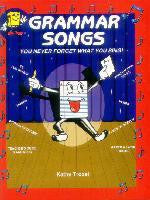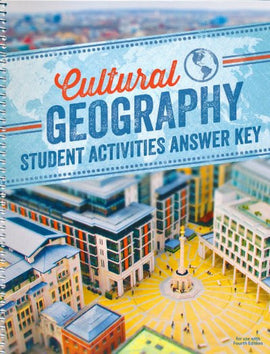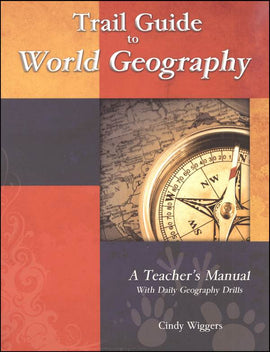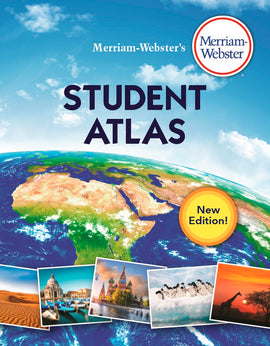Trail Guide to U.S. Geography
Trail Guide to U.S. Geography is a family-friendly, multi-level geography curriculum guide for students in grades 3 through 12. With its trail markers (animal track icons) guiding your student along three different learning paths, this book can be used for more than one academic school year and works well if you have a number of students of varying abilities learning together.
There is not one exact way to use this unique course. It was designed with flexibility in mind to better meet various objectives when teaching geography. Trail Guide to U.S. Geography provides activities and assignments for a 36-week school year on U.S. Geography.
Atlas Drills
Spend 5-10 minutes a day with the atlas drills to develop and maintain map reading skills. Some folks use the book strictly for the Geography Trails section alone and say it’s worth every penny at that!
Geography Notebook
Add an outline map with a list of places to label and students have a smooth beginning to creating a great U.S. Geography Notebook. Additional assignment choices lead students deeper to learn about key places throughout the United States. You set your pace and objectives. Spend as much time as your schedule allows. You can always use the book again another year, with all new atlas drills questions.
There are three sections of assignments for each week. You can use all three sections or any combination.
[1] Geography Trails Weekly: Days 1-4
In the weekly Geography Trails section, you will find daily short atlas drills at three different levels. Students follow their assigned trail and, using the required atlas, answer two questions a day. They gain practical experience with map reading and atlas usage in a light-hearted and natural way. Many especially enjoy the challenge of finding the answers in this 5-10 minute activity.
[2] Mapping Weekly
Weekly mapping lists provide opportunities for students to label an outline map for inclusion in their personal U.S. Geography Notebook. Most students will complete the mapping assignment in one sitting. (Outline maps are not included.)
[3] Trail Blazing — Personal Research and Discovery
The Trail Blazing section fleshes out the remainder of the school week. Here you will find a number of various type of assignments to choose from. So, in addition to the five- minute atlas drills and the mapping activity students (or teachers) select two to four of these Trail Blazing assignments each week to complete. Assignments span all learning styles and cover many topics of interest.
Students will use outside resources, such as library or Internet for most of the Trail Blazing assignments. Some examples of the kinds of assignments include creating a chart or graph, research and study, art or craft, meal planning and preparation, designing a travel brochure, making flash cards or a crossword puzzle to aid in memorization, creating an illustrated geography dictionary, and so much more.
Literature Unit Component
The final weeks of the school year we change it up with a Literature Review Unit. Using family read-aloud time and The Captain’s Dog by Roland Smith, student will map the trail of the Lewis and Clark Expedition, learn about Native Americans, plants and animals that were discovered at that time and more. Some families do this six-week unit during the summer months as an introduction to the upcoming U.S. geography studies.
The three trails represent three levels of difficulty.
Elementary
Middle School
High School
When determining the level for your student you should rely more on the student's ability to read and use an atlas than on a specific grade.
Benefits
Using Trail Guide to U.S. Geography as your core, students will:
- Gain experience with map reading using an atlas
- Create their own personal geography notebook, or portfolio
- Develop critical thinking skills
- Learn countries and capitals
- Much more!
This interesting approach to teaching makes learning fun and memorable. No student workbook is needed because students will develop their own personal notebooks full of colorful maps, intriguing facts, and surprisingly pertinent information.
Students need outline maps of each state and a U.S. Atlas. Upper grades (8th - high school) will also need a World Almanac.
ISBN 9781628630060, SKU 1030060
| Book Title | Trail Guide to U.S. Geography |
| Publisher: | Geo Matters |
| Author | Cindy Wiggers |
Trail Guide to U.S. Geography is a family-friendly, multi-level geography curriculum guide for students in grades 3 through 12. With its trail markers (animal track icons) guiding your student along three different learning paths, this book can be used for more than one academic school year and works well if you have a number of students of varying abilities learning together.
There is not one exact way to use this unique course. It was designed with flexibility in mind to better meet various objectives when teaching geography. Trail Guide to U.S. Geography provides activities and assignments for a 36-week school year on U.S. Geography.
Atlas Drills
Spend 5-10 minutes a day with the atlas drills to develop and maintain map reading skills. Some folks use the book strictly for the Geography Trails section alone and say it’s worth every penny at that!
Geography Notebook
Add an outline map with a list of places to label and students have a smooth beginning to creating a great U.S. Geography Notebook. Additional assignment choices lead students deeper to learn about key places throughout the United States. You set your pace and objectives. Spend as much time as your schedule allows. You can always use the book again another year, with all new atlas drills questions.
There are three sections of assignments for each week. You can use all three sections or any combination.
[1] Geography Trails Weekly: Days 1-4
In the weekly Geography Trails section, you will find daily short atlas drills at three different levels. Students follow their assigned trail and, using the required atlas, answer two questions a day. They gain practical experience with map reading and atlas usage in a light-hearted and natural way. Many especially enjoy the challenge of finding the answers in this 5-10 minute activity.
[2] Mapping Weekly
Weekly mapping lists provide opportunities for students to label an outline map for inclusion in their personal U.S. Geography Notebook. Most students will complete the mapping assignment in one sitting. (Outline maps are not included.)
[3] Trail Blazing — Personal Research and Discovery
The Trail Blazing section fleshes out the remainder of the school week. Here you will find a number of various type of assignments to choose from. So, in addition to the five- minute atlas drills and the mapping activity students (or teachers) select two to four of these Trail Blazing assignments each week to complete. Assignments span all learning styles and cover many topics of interest.
Students will use outside resources, such as library or Internet for most of the Trail Blazing assignments. Some examples of the kinds of assignments include creating a chart or graph, research and study, art or craft, meal planning and preparation, designing a travel brochure, making flash cards or a crossword puzzle to aid in memorization, creating an illustrated geography dictionary, and so much more.
Literature Unit Component
The final weeks of the school year we change it up with a Literature Review Unit. Using family read-aloud time and The Captain’s Dog by Roland Smith, student will map the trail of the Lewis and Clark Expedition, learn about Native Americans, plants and animals that were discovered at that time and more. Some families do this six-week unit during the summer months as an introduction to the upcoming U.S. geography studies.
The three trails represent three levels of difficulty.
Elementary
Middle School
High School
When determining the level for your student you should rely more on the student's ability to read and use an atlas than on a specific grade.
Benefits
Using Trail Guide to U.S. Geography as your core, students will:
- Gain experience with map reading using an atlas
- Create their own personal geography notebook, or portfolio
- Develop critical thinking skills
- Learn countries and capitals
- Much more!
This interesting approach to teaching makes learning fun and memorable. No student workbook is needed because students will develop their own personal notebooks full of colorful maps, intriguing facts, and surprisingly pertinent information.
Students need outline maps of each state and a U.S. Atlas. Upper grades (8th - high school) will also need a World Almanac.
ISBN 9781628630060, SKU 1030060












